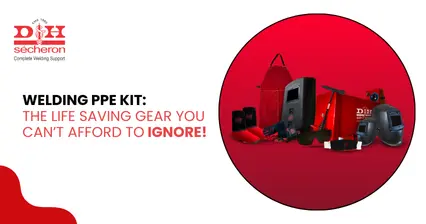Exploring Different Welding Rod Types: A Comprehensive Guide to Their Uses
Introduction
Welding is a versatile craft that demands precision and expertise. One of the critical components in welding is the choice of welding rods, which play a pivotal role in achieving strong and durable joints. In this informative guide, we'll help you understand different welding rod types and their specific applications, along with their uses and benefits. Whether you're a seasoned welder or just starting on your welding journey, understanding these welding rod types will empower you to create superior welds.
MS Welding Electrode (Mild Steel): The All-Purpose Workhorse
Mild steel welding electrodes, commonly known as MS welding electrodes, are the go-to choice for general welding applications. These versatile electrodes are designed to join mild steel components efficiently, making them suitable for a wide range of projects. From fabrication and repair work to structural applications, MS welding electrodes offer ease of use, reliable performance, and consistent results. Their affordability and compatibility with various welding techniques, such as Shielded Metal Arc Welding (SMAW), make them a favourite among welders of all skill levels.
SMAW Rods: The Foundation of Arc Welding
Shielded Metal Arc Welding (SMAW), often referred to as stick welding, relies on SMAW rods to create strong and enduring welds. SMAW rods come in various types, each designed for specific purposes. For instance, low-hydrogen electrodes minimize the risk of hydrogen-induced cracking, making them ideal for critical applications. On the other hand, rutile-coated electrodes provide smoother weld beads and better arc stability, making them suitable for both beginners and experienced welders.
Dissimilar Welding: Matching the Unmatchable
Dissimilar welding requires specialized electrodes that can join different metals effectively. Nickel electrodes come into play in such scenarios. These electrodes are engineered to weld a variety of materials, including stainless steel, cast iron, and other alloys, with different thermal properties and melting points. The unique properties of nickel electrodes make them an excellent choice for dissimilar welding, ensuring reliable bonds and durable joints.
Welding Wires: Precision in Fusion
Welding wires, also known as arc wires or filler wires, are essential for processes like Gas Metal Arc Welding (GMAW) or Flux-Cored Arc Welding (FCAW). These wires come in various compositions, including mild steel, stainless steel, and nickel alloys. The choice of welding wire depends on the material being welded and the specific requirements of the project. Welding wire manufacturers offer a wide range of options to cater to diverse welding needs, ensuring optimal performance and desired outcomes.
Selecting the Right Rod for the Job
Choosing the right welding rod is crucial for achieving successful welds. Factors such as base metal type, welding technique, joint configuration, and intended application play a significant role in determining the appropriate welding rod type. While each welding rod has its unique advantages, understanding their characteristics will enable you to make informed decisions and create welds of exceptional quality.
D&H Sécheron: Your Partner in Welding Excellence
D&H Sécheron commitment to providing high-quality welding solutions, including MS welding electrodes, SMAW rods, and a wide range of specialty electrodes, empowers welders to achieve exceptional results. With D&H Sécheron, you have access to superior materials and expert guidance that elevate your welding projects to new heights.
11 May 2025 | Welding
An In-Depth Exploration of Low-Alloy Steel: Your Comprehensive Guide
11 May 2025 | Welding
Nagpur - Bori - Tuljapur Road MSH-3 in Yavatmal District (Maharashtra)
11 May 2025 | Welding
Guidelines to Understand Gas Welding: Applications, Advantages & Disadvantages
11 May 2025 | Welding
3 Tips for Finding the Best Mild Steel Electrode for Your Application
11 May 2025 | Welding
How to Select the Right Welding Filler Wires for Stainless Steel Welding?
11 May 2025 | Welding
Building the Narendra Modi Stadium with Norma V and Autotherme-1 Electrodes
11 May 2025 | Welding
Low Alloy Steel Welding in a (PEB) Pre Engineered Building Structure
11 May 2025 | Welding
Welding Rods: Different Types and Tips for Properly Storing and Handling
11 May 2025 | Welding
Tips for Flawless Welds with Stainless Steel Electrodes: Pros and Cons
11 May 2025 | Welding
Exploring Applications and Benefits of Stainless Steel Welding Electrodes
11 May 2025 | Welding
Welding Basics: Joining Metals with Heat and Pressure - A Beginners Guide
11 May 2025 | Welding
Distinguishing Low-Alloy Steel from High-Alloy Steel: Understanding the Variations
11 May 2025 | Welding
Hard Facing Wire - Understanding the Process and Achieving Optimal Result
11 May 2025 | Welding
Exploring the Advantages of Stainless Steel Electrodes in Welding Applications
11 May 2025 | Welding
Weathering Steel vs. Traditional Steel: A Comparative Analysis of Performance
11 May 2025 | Welding
Choosing the Right Welding Rod: Why 6013 Electrodes Might Be Your Ideal Option
11 May 2025 | Welding
Why 7018 Electrodes Are Preferred for High-Strength Welds in Pipeline Construction
11 May 2025 | Welding
Filler Wire vs. Stainless Steel Filler Wire: Understanding the Key Differences
11 May 2025 | Welding
Exploring the Impact of Filler Material on Welding Quality and Durability
11 May 2025 | Welding
Choosing the Right Cast Iron Electrode for Different Welding Projects
11 May 2025 | Welding
Top Advantages of Cast Iron Electrodes for Industrial Welding Applications
11 May 2025 | Welding
Key Benefits and Challenges of Using TIG Welding in Industrial Projects
11 May 2025 | Welding
5 Reasons Why 7018 Electrode is the Gold Standard for Welding Professionals
11 May 2025 | Welding
Top 5 Advantages of Flux Cored Arc Welding for Heavy-Duty Applications.png)
11 May 2025 | Welding
Lotherme-601: A Game-Changer for Restoring Shoulder Pins in Heavy Machinery
11 May 2025 | Welding
How D&H Sécheron Helped Repair a Rotary Kiln’s Cooler Section with LoTherme 352
11 May 2025 | Welding
Piston Repair for Mining Industry: Cost-Effective Solutions with LoTherme 468.webp)






.jpg)








































.jpg)
.jpg)

.jpg)

.jpg)




.jpg)
.jpg)
.jpg)



.webp)
.jpg)
.jpg)
.webp)
.jpg)






















.png)



.webp)

.webp)
.webp)



